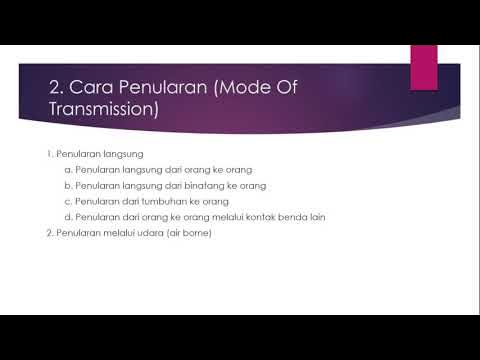Uji Kultur Ganda Bagian 2
Summary
TLDRThis video script discusses various biological control agents and their mechanisms for inhibiting pathogens. It highlights three key mechanisms: competition for space and nutrients, antibiosis, and parasitism, using examples such as *Trichoderma*, *Gliocladium*, and *Penicillium*. The script explains how agents like *Trichoderma* and *Gliocladium* can outcompete pathogens for resources, while *Penicillium* can produce antibiosis to inhibit pathogen growth. Parasitism, where agents attack and consume the pathogen directly, is also discussed. The importance of evaluating inhibition percentage through dual culture testing is emphasized, influencing future applications in the field.
Takeaways
- 😀 Biological agents can inhibit pathogens through three main mechanisms: competition, antibiosis, and parasitism.
- 😀 Competition involves agents outgrowing pathogens by occupying space and using nutrients more effectively.
- 😀 *Trichoderma* and *Gliocladium* are examples of agents that dominate space and nutrients, inhibiting pathogen growth.
- 😀 Antibiosis occurs when agents release metabolites that directly inhibit or kill pathogens, seen with *Penicillium*.
- 😀 *Penicillium* produces substances that cause pathogen cells to swell or break down, indicating its antibiosis potential.
- 😀 Parasitism involves biological agents physically attacking and feeding on pathogens, often by secreting enzymes like glucanase and chitinase.
- 😀 *Trichoderma* is an example of a biological agent that exhibits parasitism by attacking pathogen hyphae.
- 😀 The effectiveness of biological agents is often measured by their percentage inhibition in dual-culture tests.
- 😀 Not all biological agents show rapid growth but may still be highly effective due to mechanisms like antibiosis or parasitism.
- 😀 Interpreting dual-culture test results requires careful analysis of the inhibition mechanisms, as different agents may have different strengths in real-world applications.
- 😀 Determining the inhibition potential of biological agents is crucial for selecting the right agents for agricultural and ecological pathogen control.
Q & A
What is the significance of determining the inhibition percentage in a dual culture test?
-The inhibition percentage is crucial as it helps evaluate the effectiveness of a biological agent in inhibiting pathogen growth. This percentage reflects how well the agent competes with or affects the pathogen in the test environment.
What is the first step in evaluating a biological agent's ability to inhibit pathogens?
-The first step involves examining the agent's mechanisms, such as space competition, nutrient competition, antibiosis, and parasitism, to understand how it inhibits the pathogen.
How does space competition affect the inhibition of pathogen growth?
-In space competition, a biological agent that grows faster than the pathogen will occupy more space, preventing the pathogen from thriving. This results in a higher inhibition percentage, as the agent outcompetes the pathogen for space.
Which biological agents are mentioned as examples for space or nutrient competition?
-Trichoderma and Gliocladium are examples of biological agents that show the ability to dominate space or utilize nutrients better, thus inhibiting pathogen growth.
What is the role of antibiosis in inhibiting pathogens?
-Antibiosis involves the secretion of metabolites by a biological agent that either kills or inhibits the growth of pathogens. This is seen when the pathogen’s hyphae undergoes lysis or when it forms resistant structures like chlamydospores due to the agent's metabolites.
How can antibiosis be detected in the dual culture test?
-Antibiosis is detected by observing the formation of an inhibition zone around the agent’s growth, or through the death or damage to the pathogen's hyphae, which may show as ruptures or swollen cells.
Can a biological agent exhibit multiple mechanisms for pathogen inhibition?
-Yes, a biological agent may exhibit multiple mechanisms, such as space competition, nutrient competition, antibiosis, and parasitism, which collectively contribute to its ability to inhibit pathogen growth.
What is the role of parasitism in pathogen inhibition?
-Parasitism involves a biological agent physically attaching to and penetrating the pathogen's hyphae, using enzymes like glucanase and chitinase to break down the pathogen's cell walls, ultimately killing it by absorbing its nutrients.
Why might a biological agent not always show fast growth despite being effective at inhibiting pathogens?
-A biological agent may not exhibit fast growth because the effectiveness of its inhibition is more dependent on mechanisms like antibiosis or parasitism, rather than rapid growth. These mechanisms can still significantly reduce pathogen presence even if the agent's growth rate is slower.
What factors influence the interpretation of dual culture test results?
-Interpretation of dual culture test results can vary depending on the specific mechanisms involved, such as whether space competition, antibiosis, or parasitism plays the most significant role. These factors influence the potential application of the agent in field settings.
Outlines

This section is available to paid users only. Please upgrade to access this part.
Upgrade NowMindmap

This section is available to paid users only. Please upgrade to access this part.
Upgrade NowKeywords

This section is available to paid users only. Please upgrade to access this part.
Upgrade NowHighlights

This section is available to paid users only. Please upgrade to access this part.
Upgrade NowTranscripts

This section is available to paid users only. Please upgrade to access this part.
Upgrade Now5.0 / 5 (0 votes)





